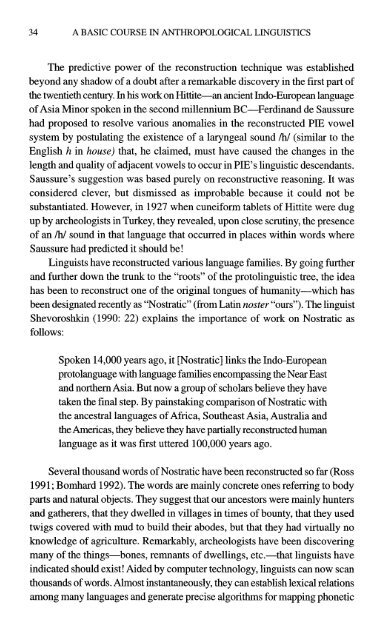A Basic Course in Anthropological Linguistics (Studies in Linguistic ...
A Basic Course in Anthropological Linguistics (Studies in Linguistic ...
A Basic Course in Anthropological Linguistics (Studies in Linguistic ...
You also want an ePaper? Increase the reach of your titles
YUMPU automatically turns print PDFs into web optimized ePapers that Google loves.
34 A BASIC COURSE IN ANTHROPOLOGICAL LINGUISTICS<br />
The predictive power of the reconstruction technique was established<br />
beyond any shadow of a doubt after a remarkable discovery <strong>in</strong> the first part of<br />
the twentieth century. In his work on Hittite-an ancient Indo-European language<br />
of Asia M<strong>in</strong>or spoken <strong>in</strong> the second millennium BC-Ferd<strong>in</strong>and de Saussure<br />
had proposed to resolve various anomalies <strong>in</strong> the reconstructed PIE vowel<br />
system by postulat<strong>in</strong>g the existence of a laryngeal sound /h/ (similar to the<br />
English h <strong>in</strong> house) that, he claimed, must have caused the changes <strong>in</strong> the<br />
length and quality of adjacent vowels to occur <strong>in</strong> PIE’S l<strong>in</strong>guistic descendants.<br />
Saussure’s suggestion was based purely on reconstructive reason<strong>in</strong>g. It was<br />
considered clever, but dismissed as improbable because it could not be<br />
substantiated. However, <strong>in</strong> 1927 when cuneiform tablets of Hittite were dug<br />
up by archeologists <strong>in</strong> Turkey, they revealed, upon close scrut<strong>in</strong>y, the presence<br />
of an /h/ sound <strong>in</strong> that language that occurred <strong>in</strong> places with<strong>in</strong> words where<br />
Saussure had predicted it should be!<br />
L<strong>in</strong>guists have reconstructed various language families. By go<strong>in</strong>g further<br />
and further down the trunk to the “roots” of the protol<strong>in</strong>guistic tree, the idea<br />
has been to reconstruct one of the orig<strong>in</strong>al tongues of humanity-which has<br />
been designated recently as “Nostratic” (from Lat<strong>in</strong> noster ours^'). The l<strong>in</strong>guist<br />
Shevoroshk<strong>in</strong> (1990: 22) expla<strong>in</strong>s the importance of work on Nostratic as<br />
follows:<br />
Spoken 14,000 years ago, it [Nostratic] l<strong>in</strong>ks the Indo-European<br />
protolanguage with language families encompass<strong>in</strong>g the Near East<br />
and northern Asia. But now a group of scholars believe they have<br />
taken the f<strong>in</strong>al step. By pa<strong>in</strong>stak<strong>in</strong>g comparison of Nostratic with<br />
the ancestral languages of Africa, Southeast Asia, Australia and<br />
the Americas, they believe they have partially reconstructed human<br />
language as it was first uttered 100,000 years ago.<br />
Several thousand words of Nostratic have been reconstructed so far (Ross<br />
1991; Bomhard 1992). The words are ma<strong>in</strong>ly concrete ones referr<strong>in</strong>g to body<br />
parts and natural objects. They suggest that our ancestors were ma<strong>in</strong>ly hunters<br />
and gatherers, that they dwelled <strong>in</strong> villages <strong>in</strong> times of bounty, that they used<br />
twigs covered with mud to build their abodes, but that they had virtually no<br />
knowledge of agriculture. Remarkably, archeologists have been discover<strong>in</strong>g<br />
many of the th<strong>in</strong>gs-bones, remnants of dwell<strong>in</strong>gs, etc.-that l<strong>in</strong>guists have<br />
<strong>in</strong>dicated should exist! Aided by computer technology, l<strong>in</strong>guists can now scan<br />
thousands of words. Almost <strong>in</strong>stantaneously, they can establish lexical relations<br />
among many languages and generate precise algorithms for mapp<strong>in</strong>g phonetic






